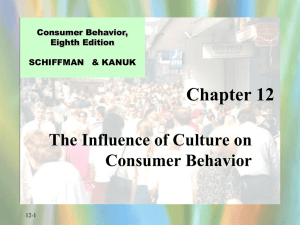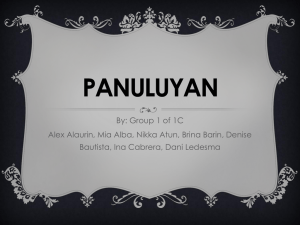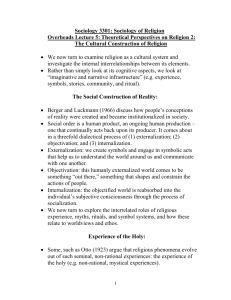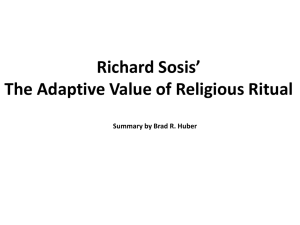Liturgy in Lent PowerPoint
advertisement
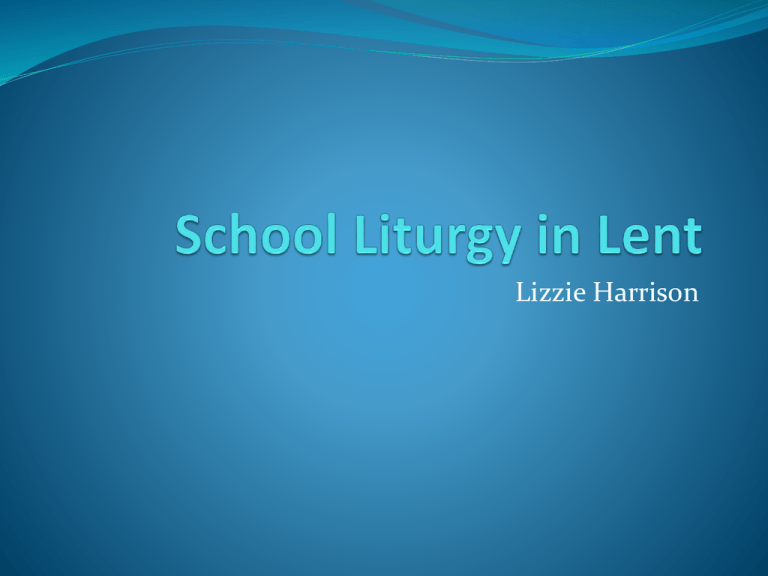
Lizzie Harrison Aims of the Workshop Simple steps to develop any liturgy Elements of ritual Setting up sacred spaces Resources for Lent Why Liturgy Encounter God Joy of the Gospel Creative, meaningful and life-giving Only experience of Church? A Personal Symbol What gives our life meaning? Symbols A symbol is an object that represents, stands for, or suggests an idea, visual image, belief, action, or material entity. Symbols take the form of words, sounds, gestures, or visual images and are used to convey ideas and beliefs. Symbols are at the heart of creative Liturgy........ Symbols In sacraments, symbols can bring about a Change in a person and reveal a deeper reality Symbols used in sacraments Water in Baptism: Symbolises new life in Christ: Symbolic actions and words transform the person making them a Christian. Anointing with oil in Confirmation: Symbol of strength hope to strengthen participant in wisdom, courage and understanding. Receive the gift of the Holy Spirit Useful symbols Some symbols are useful in many liturgies Examples of symbols in use November: Daffodil bulbs planted in November will grow in the spring and remind students that death is not the end. It is reflected in our seasons. Wailing Wall. A giant poster of a wall can be made along the idea of the wall in Jerusalem with painted bricks and the prayers of a school community can be placed on it with sticky notes over the week coming up to a special mass and used as Prayers of the Faithful. Ritual “There is no more important pastoral issue facing the Catholic Church in Ireland and internationally than the renewal of its ritual life” From Passage to Pasch by Michael Drumm (Columba Press, 1998) Do you agree? Why Ritual? “Ritual is vital to the well being of the individual and society. Without Ritual I go nowhere, I see nothing new and I do it alone. The church community which is bold enough to visit the edge may have to experience the darkness of disorientation or confusion of losing established patterns of understanding and doing but it will open itself up to the possibility of true community and closer relationships…” From A Sacramental People by Michael Drumm & Tom Gunning Why Ritual? Encounter with Christ Pre-Evangelisation/ Evangelisation Develop a relationship with God Community (communitas) Give life meaning Language to express the inexpressible/the liminal Make sense of key transitions in life - pregnancy, birth, adolescence, betrothal, marriage, death. – through the Sacraments Pope Francis (Evangelii Nuntandi) “I invite all Christians, everywhere, at this very moment, to a renewed personal encounter with Jesus Christ, or at least an openness to letting him encounter them; I ask all of you to do this unfailingly each day…” “A Church that evangelizes must always start from prayer, from asking, like the Apostles in the Upper Room, for the fire of the Holy Spirit. Only a faithful and intense relationship with God allows us to leave our enclosures and announce the Gospel with parrhesia (the obligation to speak the truth for the common good, even at personal risk). Without prayer our actions become empty and our proclamation soulless, it is not animated by the Spirit” “To evangelize, then, we must be open to the action of the Spirit of God, without fear of what He asks us or where He leads us. Let us entrust ourselves to Him! He enables us to live and bear witness to our faith, and enlighten the hearts of those we meet” Stages of Ritual? Books referenced to explain Ritual A Sacramental People, Michael Drumm & Tom Gunning Passage to Pasch, Michael Drumm Arnold Van Gennep/Victor Turner – Anthropologists Three stages of ritual Van Gennep Turner Simplified Separation Separation Welcome Transition Liminality Meaning Incorporation Reaggregation Blessing Separation – Essential Phase! “One cannot experience what happens at the threshold unless one first separates from the familiar” A Sacramental People Transition & Meaning Phase This is where change occurs; where awe and mystery are encountered Incorporation: strengthened by the transitional phase and returning to the familiar Blessing “Go in peace to love and serve the Lord” Tips for Liturgy with young people Get the threshold experience/separation from the familiar right! Preparation and participation Suitable music – highlights the celebration dimension, must be relevant Involvement – do students have a role? Are they welcomed and valued in our liturgies? Pray in their own words Theme – meaningful to and is chosen by the students Drama/Dance/Mime etc. – step into another’s shoes and challenges prejudices Send them away with something e.g. Feather, piece of scripture Remember! “We do not bring God to the young people we work with. This would be a very condescending attitude. God is already there. What we do is create atmospheres and opportunities where young people can encounter and listen to the God that is already within them. What a privilege that is. We cannot take responsibility for what happens once we create this atmosphere. God works his magic. ‘We just turn up and let God show off.’ God works not just because of us but sometimes in spite of us.” L. Harrison Thank You

